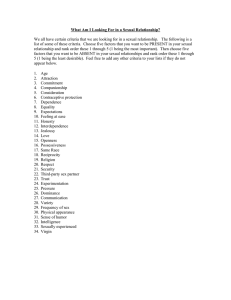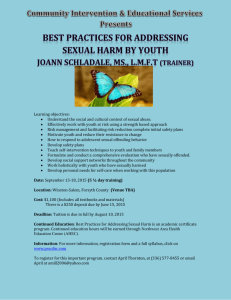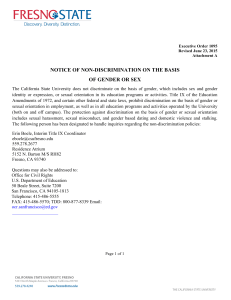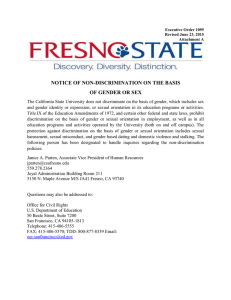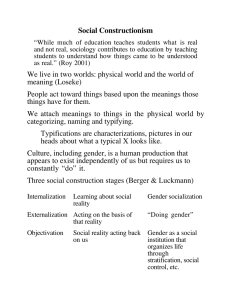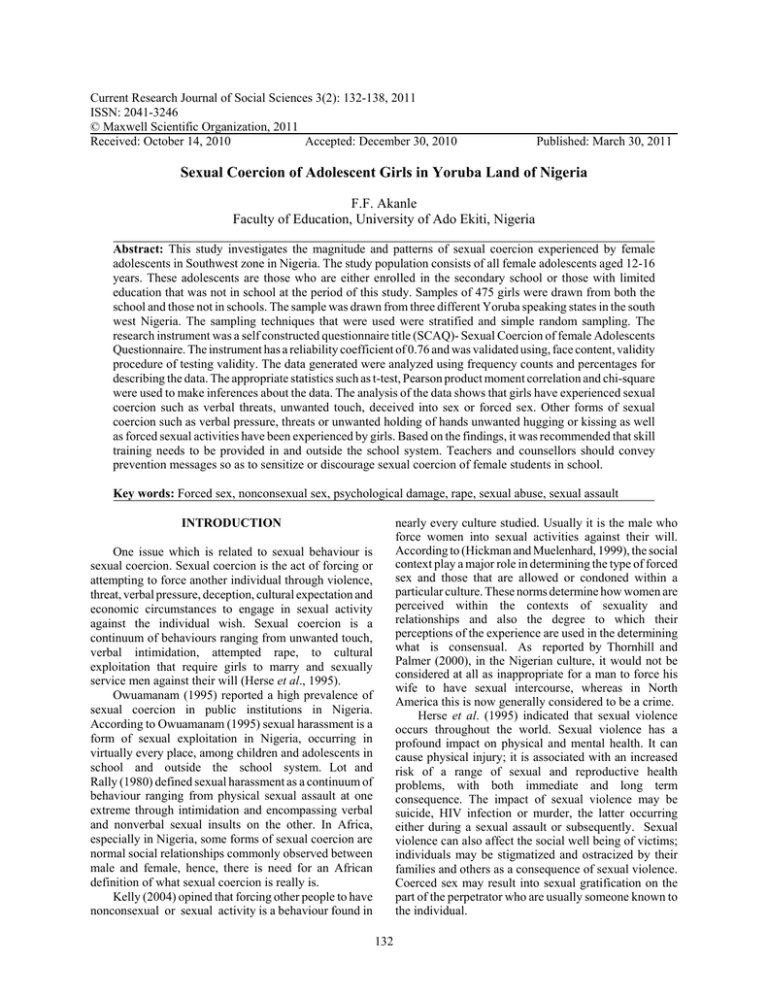
Current Research Journal of Social Sciences 3(2): 132-138, 2011
ISSN: 2041-3246
© Maxwell Scientific Organization, 2011
Received: October 14, 2010
Accepted: December 30, 2010
Published: March 30, 2011
Sexual Coercion of Adolescent Girls in Yoruba Land of Nigeria
F.F. Akanle
Faculty of Education, University of Ado Ekiti, Nigeria
Abstract: This study investigates the magnitude and patterns of sexual coercion experienced by female
adolescents in Southwest zone in Nigeria. The study population consists of all female adolescents aged 12-16
years. These adolescents are those who are either enrolled in the secondary school or those with limited
education that was not in school at the period of this study. Samples of 475 girls were drawn from both the
school and those not in schools. The sample was drawn from three different Yoruba speaking states in the south
west Nigeria. The sampling techniques that were used were stratified and simple random sampling. The
research instrument was a self constructed questionnaire title (SCAQ)- Sexual Coercion of female Adolescents
Questionnaire. The instrument has a reliability coefficient of 0.76 and was validated using, face content, validity
procedure of testing validity. The data generated were analyzed using frequency counts and percentages for
describing the data. The appropriate statistics such as t-test, Pearson product moment correlation and chi-square
were used to make inferences about the data. The analysis of the data shows that girls have experienced sexual
coercion such as verbal threats, unwanted touch, deceived into sex or forced sex. Other forms of sexual
coercion such as verbal pressure, threats or unwanted holding of hands unwanted hugging or kissing as well
as forced sexual activities have been experienced by girls. Based on the findings, it was recommended that skill
training needs to be provided in and outside the school system. Teachers and counsellors should convey
prevention messages so as to sensitize or discourage sexual coercion of female students in school.
Key words: Forced sex, nonconsexual sex, psychological damage, rape, sexual abuse, sexual assault
nearly every culture studied. Usually it is the male who
force women into sexual activities against their will.
According to (Hickman and Muelenhard, 1999), the social
context play a major role in determining the type of forced
sex and those that are allowed or condoned within a
particular culture. These norms determine how women are
perceived within the contexts of sexuality and
relationships and also the degree to which their
perceptions of the experience are used in the determining
what is consensual. As reported by Thornhill and
Palmer (2000), in the Nigerian culture, it would not be
considered at all as inappropriate for a man to force his
wife to have sexual intercourse, whereas in North
America this is now generally considered to be a crime.
Herse et al. (1995) indicated that sexual violence
occurs throughout the world. Sexual violence has a
profound impact on physical and mental health. It can
cause physical injury; it is associated with an increased
risk of a range of sexual and reproductive health
problems, with both immediate and long term
consequence. The impact of sexual violence may be
suicide, HIV infection or murder, the latter occurring
either during a sexual assault or subsequently. Sexual
violence can also affect the social well being of victims;
individuals may be stigmatized and ostracized by their
families and others as a consequence of sexual violence.
Coerced sex may result into sexual gratification on the
part of the perpetrator who are usually someone known to
the individual.
INTRODUCTION
One issue which is related to sexual behaviour is
sexual coercion. Sexual coercion is the act of forcing or
attempting to force another individual through violence,
threat, verbal pressure, deception, cultural expectation and
economic circumstances to engage in sexual activity
against the individual wish. Sexual coercion is a
continuum of behaviours ranging from unwanted touch,
verbal intimidation, attempted rape, to cultural
exploitation that require girls to marry and sexually
service men against their will (Herse et al., 1995).
Owuamanam (1995) reported a high prevalence of
sexual coercion in public institutions in Nigeria.
According to Owuamanam (1995) sexual harassment is a
form of sexual exploitation in Nigeria, occurring in
virtually every place, among children and adolescents in
school and outside the school system. Lot and
Rally (1980) defined sexual harassment as a continuum of
behaviour ranging from physical sexual assault at one
extreme through intimidation and encompassing verbal
and nonverbal sexual insults on the other. In Africa,
especially in Nigeria, some forms of sexual coercion are
normal social relationships commonly observed between
male and female, hence, there is need for an African
definition of what sexual coercion is really is.
Kelly (2004) opined that forcing other people to have
nonconsexual or sexual activity is a behaviour found in
132
Curr. Res. J. Soc. Sci., 3(2): 132-138, 2011
subject and the age of the perpetrator. If the perpetrator is
5 years older or the subject is younger than 12 years, the
situation may be assumed to be abusive. Child
molestation usually involves the use of power on a child
in order to derive sexual pleasure from the child. The
victims of abuse often blame themselves for what has
happened, concluding that they have some how been bad
or deserving punishment.
Children are often reluctant to report sexual abuse;
they lack the verbal development to explain clearly what
happened. When children report sexual abuse, they
sometimes are not taken seriously. In some instances,
adults want to avoid confrontations with relations or
friends, children who report abuse sometimes
communicate directly to close adult or professional
person, either by demonstrating what happened or by
using language (Watt, 1998).
Strong et al. (2005) reported that perpetrators of
sexual coercion may include strangers, acquaintances,
superiors or family members. Generally female victims
are more likely to be assaulted by acquaintances (such as
a friend or coworker or a family member) than by a
stranger. More often the act is accomplished by
psychological coercion alone, with no overt physical
injuries to the victim. However, even when no lasting
physical injury is sustained, the psychological damage
done by this form of intimate violation may be
substantial. Psychological damage is often particularly
severe when the sexual assault is committed by parents
against children due to the incestuous nature of the
assault. Sexual violence in most cases reflects pre-existing
social, cultural and economic disparities between men and
women. As observed Strong et al. (2005) the relationship
between the victim and perpetrators reflects existing
power differences or struggles between people, for
example older men and younger children. Its occurrence
is in terms of dominance and submission. The vast
majority of violent acts are committed by men against
women or children.
In the view of Strong et al. (2005) a wide range of
sexually violent act can take place in different
circumstances and settings. This include for example rape within marriages or dating relationships, rape by
strangers, systemic rape during armed conflict, unwanted
sexual advances or sexual harassment including
demanding sex in return for favours. Others are sexual
abuse of mentally or physically disable people. Sexual
abuse of children, forced marriages or cohabitation,
including the marraiage of children, denial of the right to
use contraceptives or to adopt other measures to protect
against sexually transmitted diseases, forced abortion,
forced acts against the sexual integrity of women,
including females genital mutilation and obligatory
inspection of virginity, forced prostitution and trafficking
of people for the purpose of sexual exploitation.
Trafficked children for instance are often promised work
in the domestic or service industry, but instead are
usually taken to borders where their passports
and other identification papers are confiscated.
Ellsberg et al. (2001) reported that in Nigeria, it seems
sexual violence has been a neglected area of research.
Many people do not report sexual violence to the police
because they are ashamed, or fear being blamed or
stigmatized. The proportion of children who either report
or receive treatment or medical services for immediate
problem related to sexual violence is also relatively small.
Studies such as Ajuwon et al. (2001) reported that the first
sexual experience for many girls is through forced sex or
unwanted sex.
According to Strong et al. (2005) a survey of 2002
readers of seventeen Magazines found 89% of girls said
they had been targets of unwanted sexual comments,
gestures, or look during their precollege school years. In
another study 85 percent girls say they have been
subjected to unwelcome sexual behaviour at least once in
their school lives. 2/3 of the girls said they were harassed
often occasionally.
Kelly (2004) reported that a substantial percentage of
children and adolescents are subjected to sexual abuse by
adults or other adolescents. This is also known as child
molesting or pedophilia. Goldmen and Padayach (2002)
observed that a term that is often used to describe the
sexual abuse of adolescents is ephebophilia. Analyses of
various surveys, in which the incidence of child sexual
abuse was reported, have concluded that about 20 percent
female are sexually abused as children or adolescents.
NASLS statistics in U.S. indicated that 17 percent of
females reported having been sexually touched as
children. The most typical forms of sexual activity
reported included genital touch, kissing, oral sex and
vaginal intercourse.
Johnson (2000) indicated that the dimension and
level of severity of potentially abusive situation depends
on the type of sexual behavior considered, the age of the
Statement of the problem: Sexual coercion according to
Ajuwon et al. (2001) is a serious public health and human
right issues. Sexual coercion is the act of forcing or
attempting to force another individual through violence,
threat, verbal inconsistence, deception, cultural
expectations, and economic circumstances to engage
in any sexual activity against his or her will.
Herse et al. (1995) defined sexual coercion as a
continuum of behaviours ranging from unwanted touch,
verbal intimidation, attempted rape, to cultural
expectations that expects girls to marry and sexually
service men against their will. In many cases, the victim
lacks choice and experience severe physical,
psychological and social consequence if she refuses
advances from such men.
133
Curr. Res. J. Soc. Sci., 3(2): 132-138, 2011
C
Owuamanam (1995) observed that sexual coercion is
one of the prevailing social problems in the Nigerian
society and it is prevalent in public institutions in Nigeria
Owuamanam (1995) observed that sexual coercion is a
common form of sexual exploitation in Nigeria. The level
of sexual coercion has now become a matter of concern
not only to guidance counsellors, social workers but also
those who are interested in the sexual reproductive health
of adolescents and children. The preponderance
occurrence of sexual coercion is noticeable recently by in
Nigeria. Igbokure in Sunday Punch April 28, 2007
reported that some female students in the primary and
secondary schools protested to the then Minister of
education Dr. (Mrs) Ezekwesili over sexual harassment
which they have been experiencing from their male
teachers. The students urged the minister to let the male
teachers know that the students came to the school to
learn and not to be sexually harassed and intimated. Girls
and women at all stages of their lifes are often the victims
of sexual coercion. However it seems much of sexual
coercion in Nigeria occurs to children and adolescents
especially the females. The southwestern part of Nigeria
consists of a major ethnic group which is referred to as
Yorubas. Many traditional mores condone coercion of
female. The society believes that a male could force sex
on female if he has spent a lot of money on her. Even if
the woman reports any violence, the society tends to
blame the female. It seems the economic crisis and
poverty in Nigeria is making the female increasingly
vulnerable to sexual coercion and making them to unable
to resist pressure from old men who provide money and
gift in exchange for sex. In some cases parents even force
their female children to marry people who offer them
money even if the marriage is against the girl’s wish.
Although rape is a criminal offence in Nigeria, some
of the victims of rape do not report cases of rape. This is
because of the belief that publicity resulting from
prosecution of cases in court may have adverse effect on
the female victim by making it difficult for her to find a
husband; organizations that could provide adequate care
and support for victims are not readily available.
Consequently victims of rape and other mild coercive
behaviour seem to suffer in silence while perpetrators go
free.
This study therefore is to explore the magnitude and
patterns of sexual coercion experienced by female
adolescent in Nigeria:
C
C
C
C
Is sexual coercion common in Nigeria?
Hypotheses: There is no significant difference in the level
of sexual coercion among in-school and out-of-school
girls in Southwest Nigeria.
Age of respondents does not determine the level of sexual
coercion.
METHODOLOGY
The design of the study is descriptive survey; the
study was conducted between January to June, 2007 in
Nigeria among girls in their 1st - 3rd years in the senior
secondary school. Those who were not in school were
also included.
The study population consists of all female
adolescents children in Yorubaland. The Yorubas are one
of the three major ethnic groups in Nigeria, and they live
mainly in the South western part of the country, they are
mainly in the South western part of Nigeria. They are
from Lagos, Kwara State, Oyo, Ondo, Osun and Ekiti
States respectively. The adolescents are aged 12-16 years.
These adolescent are those who are either enrolled in the
secondary schools or those with limited education who
were not in school at the period of this study. Data was
collected both in and out of the classroom setting.
The sample consists of 475 adolescent girls, 410 were
drawn from those in school while 65 girls were drawn out
of school. 115 were aged 10-13 years while 360 were
aged 14-16 years. The sampling techniques used were
stratified and simple random sampling. Age, status as in
school or out of school was used as stratas. A self
constructured questionnaires title Sexual Coercion of
Adolescent Questionnaire (SCOAQ) was used to collect
the data for the study.
The study defined sexual abuse as being any verbal
or physical sexual experience in the previous 12 months
that was forced against the wishes of individual. Those
below age 16 were considered as children. Five key
aspects of abuse were measured using the following
questions, have you received suggestive remarks of sexual
interaction from someone before? Has someone shown
you pictures of sexual dealing to encourage you or invite
you for sex?
Do you receive unlimited sexual advances from
someone? Have you experienced forced sex before? And
have you experienced rape before? Etc.
The questionnaire provided clear behavioral
descriptions of experiences to which subjects could
answer Yes or No. further information also dealt with the
age of the subject; the relationship of the perpetrator of
the abuse to the respondents (parents) siblings, friend,
stranger etc. The instrument was validated using content
validity procedure. For face validation three experts
determined at face value the appropriateness of the
instrument in measuring up what was studied, to ascertain
if the instrument contained the appropriate items that
What are the different types of sexual coercions
experienced by adolescent girls?
Who are the perpetrators of this coercion of young
girls in Nigeria?
What percentages of adolescents have reported acts
of sexual coercion from their teacher?
What percentage of adolescents reported severe form
of sexual coercion like rape, deceived or drugged into
sex?
134
Curr. Res. J. Soc. Sci., 3(2): 132-138, 2011
Table 1: The different types of sexual coercion, and percentages of adolescents reporting then
Yes
----------------------------N
%
Unwanted comments, gesture or talk suggesting invitation for sex
145
30.5
Suggestive remarks of sexual interaction
135
28.4
Pictures of sexual dealing to encourage one to have sex
90
18.5
Unlimited sexual advances
110
23.2
Unwanted embraces
125
26.3
Unwanted kiss
105
22.2
Being touched to stimulate one sexually
70
14.7
Unwanted folding
120
25.3
Verbal threat
50
10.5
Touching of one’s breast
60
12.6
Touching of ones buttock
100
21.1
Forced sex attempt
75
15.8
Forced to have sex
40
8.4
Experienced rape
15
3.2
Drug or deceived into sex
26
4.2
Forced to marry against one’s wish
3
3.2
Punished by an elderly person for refusing sex
45
9.5
could actually elicit the intended responses on sexual
coercion among adolescents. Expert judgments were used
to determine the content validity of the instrument. The
expert checked the extent to which the items were
representative of the content and behaviour specified by
the theoretical concept being measured. The scores of the
test administration on the adolescent girls were correlated
with that of another standardized questionnaire termed
(ESCAAQ) 2001: Using Pearson Product Movement
Correlation a correlation of 0.76 was obtained. This
indicated that the (SCAQ) Sexual Coercion among
Adolescent Questionnaire measured the same construct
with the (ESCAAQ) experience of Sexual Coercion
among Adolescent question (2000).
A reliability test was carried out on 25 adolescent
girls, who would not take part in the final study and
whose ages were 12-16 years using Pearson Product
Movement Correlation. A reliability coefficient of 0.76
was obtained. The researcher and research assistants did
the administration of the questionnaire on respondents
from the school and outside the school system. In order to
ensure that the questions were well understood by all
respondents, personal interaction with the out of school
and in school respondents was allowed by the researcher,
this ensured that the questionnaire was well understood by
respondents. In all 500 copies where administered only
475 were correctly filled and returned 25 copies were not
returned.
The data generated were analyzed using frequency
counts, percentages. Chi-square test was used in testing
the generated hypotheses. The two hypotheses were tested
a 0.05 level of significance.
No
--------------------------------N
%
330
69.5
340
714
385
81.1
365
76.8
350
73.7
370
79.9
405
85.3
355
74.8
425
89.5
415
87.4
375
78.9
400
84.2
435
91.6
460
96.8
455
95.8
466
96.8
430
90.5
In analyzing this question, data on responses of
adolescents concerned with sexual coercion were
collected and analyzed using frequency counts and
percentages. The findings are shown in Table 1.
Table 1 shows the various types of sexual coercion
experienced by young girls aged 12-16 years in Nigeria.
A variety of sexual coercion types such as unwanted
comments, gesture, suggestion, remarks touch kiss
embraces, folding and unlimited sexual advances top the
list of sexual coercion in Nigeria. The different types of
sexual coercion experienced by adolescent girls in Nigeria
include unwanted comments, gesture, suggestion and
touching of breasts and buttocks. This is mostly
experienced by girls.
Question 2: who are the perpetrators of sexual coercion
of young girls in Nigeria? In analyzing this question, data
on the responses of responses stating who forced them to
do sexual things was used. The finding is shown on
Table 2.
Table 2 shows the major perpetrators of sexual
coercion of young girls are the teachers and adults in the
life of the girls.
RESULTS
Question 3: what percentage of adolescent reported acts
of sexual coercion from their teachers. What are types of
sexual coercion?
In analyzing this question, the various experiences of
adolescents concerned with the teacher were collected and
analyzed, using frequency counts and percentages. The
findings is shown on Table 3.
Table 3 shows the different forms of sexual coercion
from the teachers who expect sex in exchange for marks
or favour with girls.
Question 1: what are the different types of sexual
coercion experienced by adolescents in Nigeria?
Question 4: what percentage of adolescents have reported
severe forms of sexual coercion in Nigeria
135
Curr. Res. J. Soc. Sci., 3(2): 132-138, 2011
Table 2: Percentages and frequency counts of those who forced adolescents to do sexual things
Those who force me to do things which are sexual
Frequency
Another student
80.75
My teacher
190
Other adults
142.5
Family member
14.25
Strangers
47.5
%
17
40
30
3
10
Table 3: Sexual coercion from teachers
Types of sexual coercion
Teacher want me to comply with his sexual overtures for marks
Teacher denied me of a benefit because I refuse sex
Collegue using sex as a form of bribe to obtain marks
Classmate obtain better grade for involvement in sexual
relationship with teacher
Yes
-------------------------------Frequency
%
90
18.0
80
16.8
115
24.2
105
22.1
No
------------------------------------Frequency
%
385
81.1
395
83.2
360
75.8
370
77.9
Yes
-------------------------------Frequency
%
3.2
460
20
4.2
40
8.4
No
------------------------------------Frequency
%
96.8
455
95.8
435
91.6
Table 4: Experience of forced sex among adolescents
rape 15
Deceived or drugged
Forced to have sex
Table 5: have you received suggestive remarks of sexual interaction from someone before
No
Yes
Total
Student
295
115
410
Non- student
45
20
65
Total
340
135
475
Xcal
0.041
Xtable
3.84
35
Touching of
Buttocks
Unwanted kiss
05
Unwanted sexual
Advances
10
Unwanted folding
15
Suggestive remarks
20
Unwanted embraces
25
Unwanted comments
Looks or gesture
30
5
Fig. 1: Percentage of adolescents who reported sexual coercion during the last 12 months, by types of sexual abuse
In analyzing this question, responses of adolescents
concerned with the experience of forced sex were
collected and analyzed, using frequency counts and
percentages. The findings are shown in Table 4.
Table 4 shows the experience of adolescent
concerning forced sex.
Hypothesis testing:
Hypothesis 1: In school and out of school do not
experience sexual coercion the same way.
In analyzing this hypothesis, data concerned with
responses of in school and out school adolescents were
collected. Chi-square statistics was used to determine the
difference in the experience of sexual coercion among
respondents who are either students or non-students. The
finding is shown on Table 5-7.
Since xcal 0.041 is < than xtable 3.84 at 0.05. Ho is
accepted. There is no significant difference in the
experience in the experience of suggestive remarks of
sexual interaction from someone among student and nonstudent adolescents.
x cal 0.167 is less than x table 3.84. Hence there is no
significant difference in the experience of sexual coercion
between girls who are in school and out of school.
Question 5: is sexual coercion a common problem in
Nigeria?
Figure 1 shows that various percentages of girls have
experienced different forms of sexual coercion such as
verbal threat, unwanted touch, deceived into sex, forced
sex and other forms of sexual coercion. Hence sexual
coercion could be regarded as a common problem in
Nigeria.
Figure 1 shows the seven top most type of sexual
coercion experienced by young girls. This is an indication
that sexual coercion is a common problem in Nigeria.
136
Curr. Res. J. Soc. Sci., 3(2): 132-138, 2011
Table 6: have you been shown picture of sexual dealing to encourage or invite you for sex
No
Yes
Total
Student
385
75
410
Non-student
50
15
65
Total
385
90
475
x cal
0.167
x table
3.84
Table 7: unlimited sexual advance from someone
No
Yes
Student
300
110
Non-student
65
Total
365
110
Total
410
65
475
x cal
4.539
x table
3.84
Table 8: Experience of Suggestive remarks of sexual interaction
No
Yes
10-13 years
75
40
14-16 years
265
95
Total
340
135
Total
115
360
475
x cal
0.604
x total
3.84
prevalence of sexual coercion in public institutions in
Nigeria, according to these researchers sexual harassment
is common form of sexual exploitation occurring in
virtually every place, among children and adolescents in
school and outside the school system. The findings of this
study about the high prevalence of sexual coercion among
children and adolescents are not surprising. This may be
because victims lack choice and faces severe physical,
psychological and social consequences if she refuses
sexual advances from the perpetrators. Also the traditional
norms condone sexual coercion of female, if he has spent
a lot of money on her. Even if the woman reports
violence, the society tends to blame the female. Finally
the economic crisis seem to be making girls increasingly
vulnerable to sexual coercion and making them unable to
resist pressure from older rich men who provide money or
gift in exchange for sex. In spite of the fact that rape is a
criminal offence victims of rape do not normally report
cases of rape for the fear that prosecution of cases in court
may have adverse effect on the female victims.
Consequently victims of sexual coercion suffer in silence
while perpetrators go free.
The findings of this study show that the major
perpetrators of sexual coercion of young girls are their
teachers and the adult in the life of the girls. About 40%
of the sexual coercion is done by teachers. This finding
agrees with a report by African right which found and
highlighted the role of the teacher in facilitating or
perpetrating sexual coercion. A recent survey in South
Africa also found that girls aged 15 years found that
school teachers were responsible for 32% of reported
cases of sexual coercion in Zimbabwe. Teachers may
perpetrate sexual coercion because the relationship
between them and their students reflects power
differentials or struggle between them and their students.
In most cases school teachers attempt to gain sex, in
return for good grades or for not failing pupils. This may
be a cause of high rate of sexual coercion among teachers
and pupils.
x cal 4.539 is greater than x table 3.84. Hence there
is a significant difference in the level of unlimited sexual
advances experienced by student and non-student
adolescents.
From the analysis in Table 5, 6, 7, it is clear that girls
in school or those not in schools experience the same
magnitude and pattern of sexual coercion in Nigeria.
However, unlimited sexual advances seem to be more
prevalent among out of school girls.
Hypothesis 2: age of respondents does not determine the
type of sexual coercion in Nigeria.
In analyzing this hypothesis, data concerned with
responses of adolescents concerning sexual coercion and
their age were collected. The data was analyzed using chisquare. The finding is shown on Table 8.
Since x cal = 0.604 is less than x total 3.84 at 0.05.
Therefore, the hypothesis is accepted. There is no
significant difference in the experience of adolescents in
terms age.
DISCUSSION
This study investigated sexual coercion among
adolescents girls whose age are less than 16years. These
girls were students and apprentices in the three different
states on Nigeria. The study yielded considerable insight
into the magnitude and patterns of sexual coercion
experienced by female in school and out of school girls in
Nigeria. The findings suggest wide pattern of sexual
coercion with variation in magnitude and types. Figure 1
shows a variety of sexual coercion such as unwanted kiss,
embraces, folding and unlimited sexual advance
characterize or top the list of sexual coercion in southwest
Nigeria or the Yoruba speaking area of Nigeria. The
finding of this research found between 3.2-30.5% of
respondents have experienced on form of sexual coercion
before.
These findings corroborate that of Owuamanam
(1995) and Ajuwon et al. (2001), who reported a high
137
Curr. Res. J. Soc. Sci., 3(2): 132-138, 2011
REFERENCES
The findings of the research show that in school and
out of school girls experience sexual coercion in the
same magnitude. These findings go against that of
Ajuwon et al. (2001) who reported a difference in the
magnitude of sexual coercion among apprentices (or out
of school) and in school girls. Hence the difference in
magnitude of sexual coercion experienced by out of
school girls in this study and that of Ajuwon et al. (2001).
The findings of this study shows age of respondents
does not determine the types of sexual coercion
experienced by them. This findings disagrees with that of
Johnson (2000) who indicated that the dimension and
level of severity of potentially abusive situation depends
on the types of sexual behaviour considered and the age
of the subject. The findings of this study may differ
because of the differences in the location of two
researches.
Ajuwon, J.J., B.O. Olley, J.I. Akin and O. Akintola, 2001.
Experience of sexual coercion among adolescents in
Ibadan, Nigeria. Afr. J. Reprod. Health, 5(3):
120-131.
Ellsberg, M., L. Heise, R. Pena, S. Agunto and Winkrist,
2001. A research in domestic violence against
women: Methodological and ethical issues. Stud.
Family Plann., 32(1): 1-16.
Goldmen, J.D. and U.K.C. Padayacb, 2000. Some
methodological problems in estimating incidence and
prevalence in child sexual abuse research. J. Sex
Res., 37(4): 305-314.
Herse I., K. Moore and P. Toubia, 1995. Sexual Coercion
and Reproduction Health: A Focus on Research. The
Population Council, New York,
Hickman, S.E. and C.L. Muelenhard, 1999. By the semimystical appearance of a condom: How young
women and men communicate sexual consent in
heterosexual situations. J. Sex Res., 36(3): 258-272.
Lot, B. and M.E. Rally, 1980. Cited by A. Somers, 1982.
Sexual harassment in academic: Legal issue and
definitions. J. Soc. Issues, 38(4): 28-32.
Johnson, T.C., 2000 Sexualized children and children
who are molested. Siccus Report, 29(1): 35-39.
Kelly, G., 2004. Sexuality Today: The Human
Perspective. 4th Edn., McGraw Hill Company, New
York.
Owuamanam, D.O., 1995. Youth: The age of contrast in
human development. The Fourth Inaugural Lecture
of the Ondo State University, Ado-Ekiti,
September 22.
Thornhill, and C.T. Palmer, 2000. A Natural History of
Rape Biological Bases of Sex Coercion. MIT Press,
Cambridge, M.A.
Strong, B., C. Devalt, B.W. Sayad and W.L. Yarber,
2005. Human Sexuality Diversity in Contemporary
America. 5th Edn., GrawHill Higher Education, New
York, M.C.
Watt, C., 1998. Witholding sex and forced sex:
Dimensions of violence against Zimbabmean
Women. Reprod. Health Matter., 6: 57-65.
CONCLUSION
The major findings of this study indicate that sexual
abuse or coercion is common among the Nigerian
population. This suggests that school is not safe and those
sexual activities among girls are not usually safe or
consensual. Teachers are the most common perpetrators
of sexual coercion. Many adolescents experience different
or multiple kinds of sexual coercion.
The implication for policy programmes are that
intervention aimed at improving reproductive health must
address issues such as personal safety and prevention of
abuse. The public at large needs to be sanitized in order to
challenge the stereotypes that favour sexual coercion.
Based on the findings of this study, it is recommended
that skill training should be organized for female students
and non-students. The media should educate the public
about the stigma associated with it. Sexuality education
programs are needed to appraise adolescent of their
optima in case of a coercion or unwanted sexual
advances.
ACKNOWLEDGMENT
The research was self sponsored however; I
acknowledge the University of Ado-Ekiti, Nigeria for
creative an enabling environment for this research and for
the inclusion of research allowance in my monthly salary.
138

